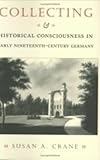Collecting and Historical Consciousness in Early Nineteenth-Century Germany / Susan A. Crane.
Material type: TextPublisher: Ithaca, NY : Cornell University Press, [2018]Copyright date: ©2000Description: 1 online resource (224 p.) : 10 halftonesContent type:
TextPublisher: Ithaca, NY : Cornell University Press, [2018]Copyright date: ©2000Description: 1 online resource (224 p.) : 10 halftonesContent type: - 9781501723599
- 943/.0072 23
- online - DeGruyter
| Item type | Current library | Call number | URL | Status | Notes | Barcode | |
|---|---|---|---|---|---|---|---|
 eBook
eBook
|
Biblioteca "Angelicum" Pont. Univ. S.Tommaso d'Aquino Nuvola online | online - DeGruyter (Browse shelf(Opens below)) | Online access | Not for loan (Accesso limitato) | Accesso per gli utenti autorizzati / Access for authorized users | (dgr)9781501723599 |
Frontmatter -- CONTENTS -- PREFACE -- 1. THE HISTORICAL SUBLIME -- 2. THE COLLECTION AND PRESERVATION OF HISTORICAL OBJECTS -- 3. Collective Collecting in ”The Age of Associations” -- 4. Finding Form for the Content:· Historical Museums -- 5. Collective Memory and Historical Consciousness -- BIBLIOGRAPHY -- INDEX
restricted access online access with authorization star
http://purl.org/coar/access_right/c_16ec
This provocative book challenges long-held assumptions about the nature of historical consciousness in Germany. Susan A. Crane argues that the ever-more-elaborate preservation of the historical may actually reduce the likelihood that history can be experienced with the freshness and individuality characteristic of the early collectors and preservationists. Her book is both a study of the emergence in late eighteenth- and early nineteenth-century Germany of a distinctively modern conception of historical consciousness, and a meditation on what was lost as historical thought became institutionalized and professionalized. Public forms of remembering the past which are familiar today, such as historical museums and historical preservation, have surprisingly recent origins. In Germany, caring about the past took on these distinctively new forms after the Napoleonic wars. The Brothers Grimm gathered fairy tales and documented the origins of the German language. Historical preservationists collected documents and artifacts and organized the conservation of cathedrals and other historic buildings. Collectors formed historical societies and created Germany's historical museums. No single national consciousness emerged; instead, many groups used similar means to make different claims about what it meant to have a German past.Although individuals were responsible for stimulating new interest in the past, they chose to band together in voluntary associations to promote collective awareness of German history. In doing so, however, they clashed with academic and political interests and lost control over the very artifacts, collections, and buildings they had saved from ruin. Examining the letters and publications of the amateur collectors, Crane shows how historical consciousness came to be represented in collective terms—whether regional or national—and in effect robbed everyone of the capacity to experience history individually and spontaneously.
Mode of access: Internet via World Wide Web.
In English.
Description based on online resource; title from PDF title page (publisher's Web site, viewed 26. Apr 2024)


